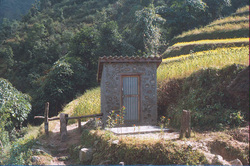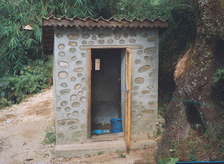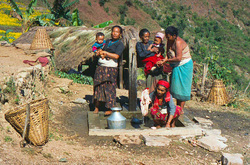"Latrines for Locals" Project 2014
What is a Latrine
A latrine is simply a waste collector, it is the equivalent of a bathroom in a rural setting.
Why this is important
Kabhre Rural Development - Nepal School Projects plans to construct up to 1200 permanent latrines for local residents use in the Kabhre region of Nepal, Palanchok district. In addition to the construction, an awareness educational program will be delivered to local residents improving their understanding of hygiene and the importance of a healthy lifestyle. Installation of a bio-gas component would also be encouraged as an addition to the latrine system to further support a healthier lifestyle. The new latrines will directly and positively impact the lives of over 13,000 villagers who will benefit from a cleaner and healthier living environment.
What we plan to do
- Raise $450,000 (1200 Latrines @ $375 per latrine)
- Local NSP Field Staff will engage with local “Village Project Committee Members” by mentoring them and developing their competency in managing these projects and installing the latrines.
- The local villagers will also make a substantial contribution of their own by donating all locally available materials such as stone for masonry wall; sand needed for mortar and fiber-concrete roofing tiles; all unskilled labor. The value of villagers’ contribution is equal to that provided by the project.
How you can help
1. Donate money towards a latrine or buy a latrine for $375.
2. Volunteer to help out with the Latrines for Locals project. We need volunteers to help fund raise and also administer the program.
2. Volunteer to help out with the Latrines for Locals project. We need volunteers to help fund raise and also administer the program.
Success to date...

In 1995, NSP introduced sanitation as an integral part of our Drinking Water Program. Initially, we were unable to sell the villagers on the idea of having simple pit latrines close to their homes. UNICEF promoted such latrines and even published a manual on how to construct one. However, the concluding paragraph stating that the pit latrine should be replaced every four years made the villagers reject sanitation. We have consulted other NGOs on their experience with sanitation to find alternatives to pit latrines. Since we have made sanitation mandatory part of all school projects, we have decided to offer a simplified version to the villagers. The latrines are of identical size, have the same high quality fixtures except for the running water tap inside. The latrines are being constructed by the benefiting villagers under our technical supervision. Since the latrines are permanent, the sanitation program became an unqualified success.
The three illustrations below are samples of recently constructed latrines. The one on the left even has a running water tap inside. Since we have been mandated by CIDA to provide assistance with sanitation to all households that received our assistance with drinking water systems, we have received more than 3,000 requests for assistance with their construction. Following the establishment of biogas industry in Nepal, we have made the necessary design modifications so that they can be retrofitted with biogas plants and biogas cooking stoves.
Water Systems Constructed to date – 272
The three illustrations below are samples of recently constructed latrines. The one on the left even has a running water tap inside. Since we have been mandated by CIDA to provide assistance with sanitation to all households that received our assistance with drinking water systems, we have received more than 3,000 requests for assistance with their construction. Following the establishment of biogas industry in Nepal, we have made the necessary design modifications so that they can be retrofitted with biogas plants and biogas cooking stoves.
Water Systems Constructed to date – 272


